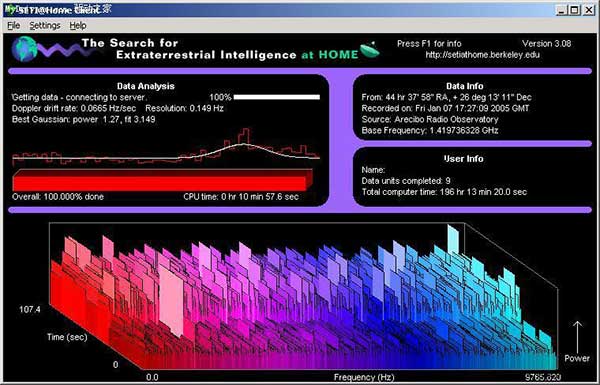
TMT.ORG; SETI@home on a home computer.(Photo provided to China Daily)
East-West cooperation
The Five-Hundred-Meter Aperture Spherical Telescope, now being built deep in the mountains of Guizhou province in Southwest China, will become the world's largest radio telescope once completed in September.
With a dish the size of 30 football fields, FAST is 500 meters in diameter and made of 4,450 panels. Scientists have depicted it as a super-sensitive ear that will be able to detect very weak messages - if there are any - from any relatives we may have out there.
It will be 10 times more sensitive than the telescopes in the Breakthrough Listen project, a $100 million initiative by Russian tycoon Yuri Milner to search for extraterrestrial civilizations, says Li Di, chief scientist with the radio astronomy department of the National Astronomical Observatories of China.
Werthimer is seeking cooperation with Chinese astronomers to develop a SETI@home project for FAST. "We hope to work with China to do SETI at the same time while the telescope carries out sky surveys to search for pulsars, fast radio bursts and to map the galaxy as planned."
Though unsure of how such collaboration would work, Li Di is interested in working with the SETI@home project. "With their experience and advanced technologies, they will help us improve the telescope's scientific capabilities and operating conditions. It's like standing on the shoulders of a giant."
Active participation
Chinese scientists have also actively participated in the preparations for the Square Kilometer Array, a large multi-radio telescope project to be built in Australia and South Africa.
It will eventually use thousands of dishes and up to a million antennas, which will enable astronomers to monitor the sky in unprecedented detail and survey the entire sky much faster than any system now operating. The search for extraterrestrial life is one of its key science programs.
Scientists have surveyed the entire sky with radio telescopes for a half-century now, and they have found interesting signals occasionally.
On August 15, 1977, a strong narrow-band radio signal, bearing the expected hallmarks of extraterrestrial origin, was detected by Jerry Ehman, an astronomer working on a SETI project at the Big Ear radio telescope of Ohio State University. The signal appeared to come from the constellation Sagittarius and lasted 72 seconds.
Ehman circled the signal on the computer printout and wrote the comment "Wow!" beside it, which that event is now commonly called. But it has never been detected again.
"Some strange signals have been found, but it's hard to confirm their origins, because these signals do not repeat," Li Di says.
"We look for not only television signals, but also atomic-bomb signals. We shall give full play to our imaginations when processing the signals. It's a complete exploration, as we don't know what an alien is like."
Radio telescopes sometimes misread signals from astronomical objects. For example, astronomers once mistook signals from a pulsar for extraterrestrial signs, because a pulsar can also give out very stable periodical signals.
"We don't know when earthlings will discover ET," Werthimer says. "It could be 1,000 years from now, or in our lifetimes. It could be next year, when FAST gets going on the sky surveys."
However, with no clues of extraterrestrial life over the past 50 years, questions are constantly asked as to whether the search methods are appropriate.
Even on Earth, land and sea host completely different forms of life. "It is highly possible that life on other planets is entirely different from that on Earth, and it might not be carbon-based," says Jin Hairong, deputy curator of Beijing Planetarium.
Liu Cixin, a Chinese science-fiction writer and winner of the Hugo Award for his novel The Three Body Problem, says the current method assumes that aliens also communicate in radio waves. "But if it's a truly advanced civilization, it is possible to use other more advanced forms of communication, such as gravitational waves."
Mao believes many methods deserve a try.
"Who knows what they are and how they think?"
When we study the origin of life, he says, we risk going down a blind alley if we stick rigidly to life on Earth as the model to look for.
He cites astronomy to illustrate how earthbound thinking can hobble scientific inquiry.
When scientists started looking for planets around sunlike stars, he says, they worked on the supposition that these planets' orbits would give them a much longer year than ours. In fact, the first such planet discovered outside our solar system takes just four days to orbit its host star, an observation that many were skeptical of because it runs counter to their experience.
"If we really discover extraterrestrial life, I'd like to know how life spreads in the universe. Is it distributed uniformly in space, or clustered?
The more samples of life we find in the universe, "the more comprehensively we can look at the puzzle and solve it more easily", he says. But then again, should Mao, get his wish to satisfy his curiosity, not all are convinced that mankind would be the better for the experience.


















































